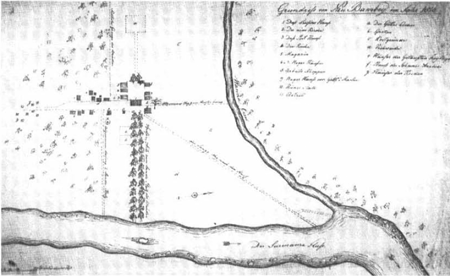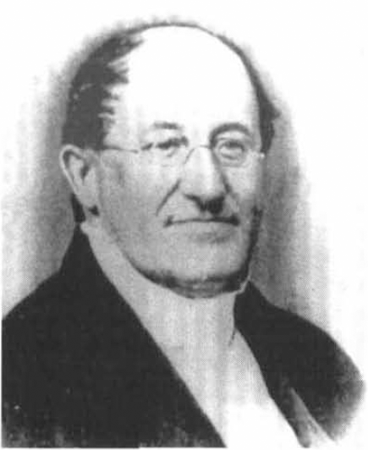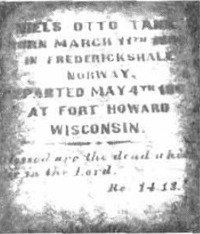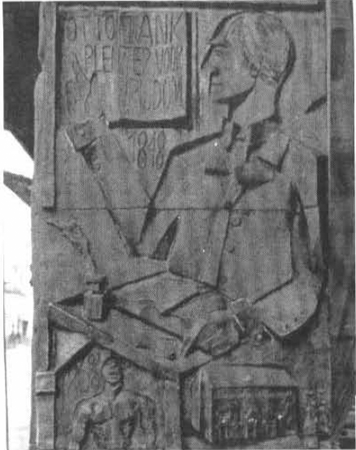OSO. Tijdschrift voor Surinaamse taalkunde, letterkunde en geschiedenis. Jaargang 23
(2004)– [tijdschrift] OSO–
[pagina 322]
| ||||
Mary Killough
| ||||
[pagina 323]
| ||||
Tank suitable to fill the need for an administrator for church owned Kersten & Company in Suriname. Tank was ordained deacon in the Moravian Church before leaving for Suriname.  2 The family's country estate of Rod, Halden, Norway
The Tanks arrived in Suriname in September 1842, after a 32 day voyage front Europe. Two years later Mariane Tank died and is buried at Maria's Rust in Paramaribo. Otto Tank asked Moravian church authorities for permission to return to Europe with their daughter Mary. However, shortly before his departure the head of the Moravian Church in Suriname, Wilhelm Treu, died, and Tank was asked to fill his position until May 1847 when additional missionaries arrived.Ga naar voetnoot1 Tank's diaries recorded in the Missions-Blatt aus der BrüdergemeineGa naar voetnoot2 tell of his experiences while visiting outlying mission posts of the Moravian Church in Suriname and several islands in the Caribbean. He made these journeys with a great deal of enthusiasm and recorded his experiences in a lively and precise way, although through the lens of an ardent Christian missionary. His academic training in geology and mineralogy and personal interest in forestry-his father had been in the lumber trade- proved useful. | ||||
Slaves and christianityTank's diaries include trips to many other plantations and reports of progress being made at the various mission stations and in Paramaribo. In correspondence with Mission headquarters in November 1846, Tank tells of the progress in bringing Christian instruction to the plantations. He is amazed at the numbers of slaves wishing to become Christian, considering what they must renounce in the way of their idols, festivities and that they must subject themselves to church discipline. Thousands in the city, as well, wished to take instruction and there were scarcely enough missionaries to do the job adequately.Ga naar voetnoot3 | ||||
[pagina 324]
| ||||
Although the missionaries opposed the injustice of slavery, Tank complains that they were often in a difficult position because they wished to serve the slave population but had to stay on good terms with their owners. One plantation manager blamed the previous year's famine at the plantation on the fact that slaves were given free time to go for instructions. Superstitious people blamed misfortunes on the church. Tank notes that Sister Voigt was busy instructing children at AndresaGa naar voetnoot4 Plantation on the Coppename River and Sister Hartmann at Berg en Dal Plantation. He speaks of Moravian Mission work progressing at Drie Gebroeders, Vertrouwen, Wayampibo, Zorgvliet, Schoonoord and other plantations.Ga naar voetnoot5 He tells of a trip with the English Bible Society agent, Mr. MacMurray, to the free Bush Negroes. MacMurray said he was happy to see free Bush Negroes there ‘in their original state, just as if they were on the banks of the Niger River in their homeland’.Ga naar voetnoot6 He brought news of freed Blacks in Jamaica. The Captain of other tribes on the Marowijne River heard about MacMurray's visit and sent people to hear his message. Tank describes the encounter as follows: ‘It was my intention to show our English friend that the English Bible Society's gift of a new edition of the New Testament, which had just arrived from Holland, and his visit to us from Berbice at the same time are not wasted on our slaves. For on almost every plantation we visited on our trip, from Warappa Creek to Bush Negro territory, we found Negroes who could read. At Plantation Berg en Dal tears came to his eyes, because when we arrived there at 9:30 in the evening, we found the church full of people who had been prepared for the occasion by Sister Hartmann. She had divided them into various groups, and only a few children found it too late to remain up. “We have also seen this in Jamaica”, he said. “We have experienced the same hunger for instruction there too!” -and tears glistened in the shining eyes of this big, strong man.’Ga naar voetnoot7 Due to Mr. MacMurray's visit the Moravians gained access to the largest plantation in the colony, Alkmaar, which had a population of almost 600 slaves. It had English owners and was managed by an English agent living there. The agent helped the missionaries get permission to conduct lessons there. Soon the nearby plantation of Visserszorg with 500 slaves followed suit. A great number came to register for instruction, the children alone numbering one hundred twenty-six.Ga naar voetnoot8 Tank loved the challenge of travelling in the remote | ||||
[pagina 325]
| ||||
areas of Suriname and enjoyed navigating the waterfalls of the Marowijne River, higher than the Sissabo on the upper Suriname River he had reported on. He praises the black helpers who interpreted for MacMurray on this trip.  3 The Moravian post at New Bambey.
| ||||
Trip to new bambeyIn May and June 1845 Tank made a trip to the Moravian post at New BambeyGa naar voetnoot9 (illustration 3) on the Suriname River because Rasmus Schmidt, a missionary there had died recently. He departed by corjalsGa naar voetnoot10 from Paramaribo the evening of 17 May 1845 with several black church members and reached Joden Savanna before the following evening. The party set up camp at a small timber plantation nearby, held evening devotions, sang hymns and retired to their hammocks. The following morning they proceeded to the Moravian mission station at Berg en DalGa naar voetnoot11 and were welcomed by the congregation there which was celebrating the second day of Pentecost. They reached Victoria the following noon, where BrotherGa naar voetnoot12 Räthling had baptized ten people | ||||
[pagina 326]
| ||||
the day before. Tank reports one of his culinary adventures on the trip; he tried iguana and found it quite tasty. Tank was very impressed with the way the black helpers could fight their way up through the rapids and describes his impressions in a very lively manner:  4 Otto Tank
‘Beyond Victoria the entire valley had been transformed into a mighty river, which flowed onward, forming whirlpools and covering all but a few of the rocks and islands that you could normally see in the dry season. We overnighted at Hamwatra, below the waterfall, where we were joined by our Negro brother, Franz, from the village Tiatja. On the 21st we reached the place where the waterfalls normally begin. But given the present water level, they were not visible for the most part. We tried to make our way on upwards through a side channel. The ability of the Negroes to work their way up over a waterfall is really fantastic. The complete fearlessness and dexterity with which they expose themselves to the raging river, in an almost playful manner, provides a very intriguing drama. Everything depends on the proper positioning of the body. With unbelievable power and presence of mind the Negro plays in the raging elements like an amphibian and swims in the foaming currents. In this manner they lift and pull the corjals up the enormous expanse of the river at places where it is not possible to row. Everything depends on placing the boat in the right direction in the river and being able to escape dangerous situations quickly. The two Negroes bringing up the rear saved the heavily loaded corjal, which had been lifted over the rocks, by pulling back on it just as the two people in front had lost their footing in the water and the strength to hold onto it as well. | ||||
[pagina 327]
| ||||
even the rotten tree trunks under the high trees, is covered with pineapple plants, but the fruit only grows to the size of a fist. The plant has long, sharp leaves. This plant, which is worth so much in Europe, grows all over here.’Ga naar voetnoot13 Tanks party passed a former settlement and commemorative stone erected in the river by the deceased Brother Hans Wied marking the place where he and his companions had celebrated Christmas Eve in 1840. Tank describes the scene: ‘The decaying, deserted houses are built on lovely white sand, and the entire place is strewn with obia (idolatrous objects). These are sticks which are fixed in the ground and split at the top. Something is stuck into the slit which is supposed to catch spirits. Spirits are sometimes banished underneath rocks. They are said to grow in planted bananas and to be present in all types of basketry interwoven with certain kinds of wood. In my holy zeal I kicked over one of those rotten branches which was standing in the way. In order to avoid trouble with the inhabitants, I smoothed over this defamation of their gods by giving several small gifts to the people on our return journey.’Ga naar voetnoot14 On May 23 the party attempted to detour around the PadraGa naar voetnoot15 waterfall through small channels. Tank describes an attack by a swarm of wasps and the beauty of the greenheart, acacia and giant upru-treesGa naar voetnoot16 with gigantic blossoms. Every evening ended with religious devotions and explanations of biblical stories by Tank. They met up with a Negro named Jan, who had been baptized and whose family lived in Bambey; he helped them navigate several waterfalls.Ga naar voetnoot17 ‘We then saw some glorious white hupru trees, which formed beautiful giant bouquets of more than one hundred feet in circumference and which created a lovely contrast to the unending green and blinding bright yellow of the majestic greenheart trees. During the dry season the greenheart trees tower above the forest like blinding torches, since you can see only flowers on this giant tree and not a single leaf. The giant acacia as well, with footlong pods, graces the forest with its glorious red blossoms. Soon after we had gone around a six to seven foot high waterfall by using a side channel, we got to the famous eighteen-foot high Sissabo Waterfall. It is very steep | ||||
[pagina 328]
| ||||
and, at one spot only, there is a flat rock over which the unloaded boots can be carried. This is dangerous because of the slippery water grass which grows on the rocks. Many a boat and its cargo have gone to ruin here. Because of my experience in my Norwegian homeland, I had brought a long rope, which we attached to the first corjal. It proved to be a great help for pulling the boats up and letting them down. I almost had to force the Negroes to use the rope, as they stuck firmly to their own methods. In one and a half hour's time we managed to climb up above the waterfall, and we continued among lovely groups of islands.’ They set up night camp close to the Batra Waterfall, making a roof of pineapple leaves on which to hang their hammocks. They held evening services among rice stalks ‘as tall as a man’.Ga naar voetnoot18 Tank describes his approach to Bambey: ‘We climbed a hill through the low shrubbery, and there in front of me I caught sight of a friendly-looking, if not exactly neatly organized, little village. At one end of the village was a nice little church and the mission house, in which I found our dear Sister Schmidt, in good health even though sad in spirit.Ga naar voetnoot19 This little place lies on the ridge of a massive hill; between the rows of houses a broad street leads to the church and to the mission buildings, whose roofs and walls are made of leaves woven in a decorative fashion. Only the church has walls of split cedar. A sturdy fence of split logs encloses the garden of the mission house and an area planted with sugar cane, bananas, coffee trees and other fruit trees. The broad paths leading to the brook, from which drinking water is brought, and to the cemetery and other places are covered with neatly kept gravel. The garden plots for planting rice, corn, and other things which the Negroes have planted for their teachers are located where Old Bambey used to be. The graves of deceased missionaries are marked by two stones. The many fruit trees that are still standing there are an indication that Europeans have lived here at one time because the Negroes seldom remain long enough in one place to plant very many trees.Ga naar voetnoot20 | ||||
Among the Cottica AukanersTank reports on work among the AukanersGa naar voetnoot21 at Sara Creek and tells that on December 28 of that year, Affiba, the wife of Franz Bona, a well-known Christian, was baptized. However, he voices his concern for the free Aukaners on the upper Commewijne River. The Moravians opened a church at Wayambo, the most distant plantation on the upper Commewijne River, and they were very well received there. In 1848 Tank made a trip to the Aukaners living in the Cottica region. | ||||
[pagina 329]
| ||||
‘In contrast to all this, our ears were greeted by the distant sound of heathen drums coming from the first Auca village, where a funeral service had been in progress all through the night and right up to the break of day. In earlier days none of our brothers dared to approach a Negro, and now we have thousands of them in our care. Two of them were with me, two who were genuinely pleased to be able to bring the redeeming Gospel of salvation to their heathen brothers in the wilderness. ... With a sigh I entered the first Auca village, Quassi Brokohede. Soon I was warmly greeted by Captain Quassi of Hansilo and Quami of Companilo, whom I already knew well, and their numerous relatives and others, whose faces I recognized, having met them in the city earlier. We conversed a long time - as well as we could with people who had spent the last four days and nights in a row at a burial feast with all its noise and commotion. Of course they could endure this far better than we could. | ||||
[pagina 330]
| ||||
ness together. I had to seek them out, and they appeared very happy that one of us whom they had heard so much about had come to visit them for a change. Even the children showed no fear. Several came to greet me. It seemed strange to me that here again, as during my first visit to the free Negroes at an earlier time, I should arrive just as a burial was in progress. This burial feast with its frightful excesses of drinking and eating, shooting and rollicking, which often goes on for days and weeks at a time, is not exactly the best moment in which to begin to spread the Gospel. The drama that the Negroes put on at their burials, in which they pretend that the body never wants to leave the village willingly, is a way to show those left behind the attachment of the dead for them. This leads to gruesome practices. But the drama has a deeper meaning. They carry the body around to find out who the murderer was. (Note: There is a belief among the heathen that the person has been poisoned. Suspicion, of course, must rest upon someone, and that becomes the continuous source of mistrust, contention and enmity among families.) For these people, death is always the work of an evil spirit, which needs some person as its tool. If the supposed murderer is discovered, then that person is unmercifully burned to death in the most frightful manner. This is a living picture of the power of grace, which appears in our days. Many heathens now use the death of a relative an opportunity to throw away their idols and to seek their salvation in Christ.’Ga naar voetnoot22 The party continued their trip on the river, which Tank judged to be always between 26 and 50 feet deep and very beautiful. At Cassipura they entered Baku Creek where Captain Quabinda of Pedelo had his village, but soon turned around. They passed a second village, Tamarinda-Ondro but did not go onto land. Instead they reached a place on the western bank of the Commewijne River at the mouth of Combee Creek, where an unnamed government representative, or post holder, resided in a small house. Tank and his companions received a warm welcome from him. He had not seen a white face for one and a half years. He knew the Bush Negroes well and shared his experience of many years with Tank. This government agent had written many useful reports, telling of Auca rejection of all suggestions from the government. From this location Tank and his party travelled up the Cottica River and reached the Coermotibo River after 45 minutes. They hunted for the military post Jerusalem but found only a ditch. They proceeded to Bossoegron, a quarter of an hour from their last stop. There they conversed with Captain Andries of Battra-lo and his family, who were very friendly to the party. Three days further along the Cottica River they discovered deserted dwellings of former colonists and cocoa and coffee trees which were still thriving on their | ||||
[pagina 331]
| ||||
own after 80 years. Then came settlements which were still inhabited: Conow-Moffe, Lievelust, and Nieuw-Kondre. Even fewer people lived on the Coermotibo River in the villages of Paramacca-ondro, Tukriki, Mongoantioni, and Koffykampo, where there was very little cultivated land. They did, however, meet some people acquainted with the work of the Moravian Church. But most of the villages were half empty and the Tank party turned back. They found no one living at Wana Creek near the passage to the Marowijne River. | ||||
Return to EuropeOtto Tank had asked to leave Suriname after his wife in died in 1844 but was persuaded to stay on to help administer church affairs. Finally in May of 1847 he and his daughter Mary left for New York by way of several stops in the Caribbean: Grenada, Martinique, Guadeloupe, St. Vincent, St. Lucia, St. Thomas, St. Croix, and St. Jan. At each place Tank visited Moravian and other churches. He writes vividly about the contrast between the freedom enjoyed by Blacks in those places and the pour treatment slaves still received in Suriname. Tank and his daughter Mary returned to Germany for rest and to plan his campaign to better the conditions of the slaves in Suriname. In a letter to the editor of the Missions-Blatt of 8 June, 1847 Tank had written: ‘because my free Norwegian spirit offen finds it difficult to move within the constraints of the depressed spirits of a slave population such as we work with and because I fear spoiling our work by expressing ideas prematurely' he could not discuss problems in Suriname publicly while there.’ Now that Tank was back in Europe he felt free to act. He travelled to Holland in 1848 and began his letter writing campaign. In May of 1848 he sent a Circular Letter (Aan de Heeren Eigenaars) to the absentee landlords of the plantations in Suriname, spelling out the miserable conditions under which the slaves lived and the lack of promised cooperation with the Moravian missionaries. He cited many instances of obstruction of missionary work, for example, by overseers threatening slaves with punishment should they attend church services. Then he made clear proposals as to how to remedy the situation. Many owners defended their positions in rebuttals, and Tank restated his views in a second letter to the owners and administrators of plantations. In a letter of 13 April 1848 to the Minister of the Navy and Colonies (Aan de Minister), Tank outlines the history of the Moravian Church presence in Suriname and asks that the government agree to several points: recognition of their status in Suriname, access to plantations and the freedom for slaves to attend church and schools. He asks that slaves be allowed to marry and that members of slave families not be separated. In exchange for these concessions, the Moravians would build schools, provide school materials and teachers, and train assistants from the native population. The result of Tank's effort was a yearly grant from the Dutch government of 2000 guilders and | ||||
[pagina 332]
| ||||
official recognition of the Moravian Church. Tank also wrote to the King of the Netherlands (Aan Zijne Majesteit) in April of 1848 asking for amnesty for 8-12,000 runaways, who live deep in the jungles of Suriname. He felt that the Aukaners were too powerful and if these runaway slaves were given amnesty they would settle down and weaken the Aukaners. He asks for a suitable piece of land where Moravians could educate that runaway slaves.  5 Tanks's gravestone at Niesky Hill Cemetery, Bethlehem, Pennsylvania, USA.
While in Holland, Tank renewed acquaintance with Caroline van der Meulen of Amsterdam, the daughter of renowned clergyman Reverend Reinhard Jan van der Meulen. Caroline had been a school chum of Tank's first wife, Mariane, while she and Caroline were pupils at the Moravian Girl's School in Zeist, Holland, which had been established by Mariane's father. In August 1849 Tank married Caroline in Zeist, and together with Tank's daughter Mary, they went to Moravian Church North American headquarters in Bethlehem, Pennsylvania. There they heard of the need to help a group of Scandinavian Moravians wishing to settle in Wisconsin. The Tanks answered this call and purchased a tract of land at Fort Howard (now Green Bay), Wisconsin, USA. This plan did not work out and the Scandinavian group moved further north to form the seulement of Ephraim, Wisconsin. One can only speculate whether Tank continued his interest in events in Suriname after 1848 or what his opinions were about the slavery question in the USA. since his wife destroyed all his letters and papers after his death, in accordance with his wishes. Tank speur the rest of his days in Fort Howard and was active in civic and business affairs until he died in 1864, one year after the emancipation of the slaves in Suriname and one year before the abolition of slavery in the USA.Ga naar voetnoot23 Tank's home can now be visited as part of Heritage Hill State Park in Green Bay, Wisconsin. Daughter Mary died in 1872 and Caroline in 1891. They all lie together in the Niesky Hill Moravian Cemetery in Bethlehem, Pennsylvania (illustration 5). | ||||
[pagina 333]
| ||||
Primary sourcesAan de Heeren Eigenaars en Administrateurs van Plantaadjes in de Kolonie Suriname, or Circular Letter, Unitäts-Archiv, Herrnhut, Germany. R15La Nr10251848 or Rijksarchief Utrecht 824-6. Aan Zijne Majesteit den Koning der Nederlanden, 27 April 1848, Rijksarchief Utrecht, the Netherlands ZZG 824-9. Tank aan de Minister van Marine en Koloniën, 13 April 1848, ZZG 824, Rijksarchief Utrecht, the Netherlands | ||||
References
Mary Killough has a Ph.D. in German language and literature from the University of Texas (Austin). She lived in Suriname from 1983-86 while her husband, Patrick Killough was posted to the U.S. Embassy there. Until recently she taught German language and literature and English as a second language. She now lives in North Carolina. |
|


